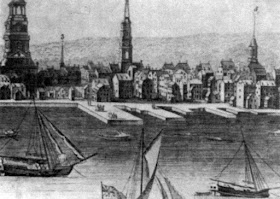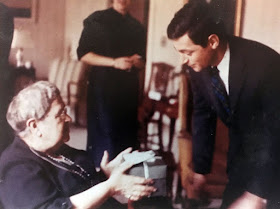In last
week’s article, we retraced the steps of John Glessner’s immigrant ancestor,
Henry Glessner, from Bingen am Rhein, Germany, to the wilderness of western
Pennsylvania in 1763 and followed the events of his life over the next half
century until his death in early 1814. In this installment, we will look back at
visits to Pennsylvania made by various descendants through the years, anxious
to learn more about their German roots in the United States.
1888
– John Glessner and Jacob Glessner
Jacob Glessner
In May
1888, John Glessner accompanied his father Jacob on a trip to Somerset,
Pennsylvania where the elder Glessner had been born in 1809 but had not visited
since his marriage and removal to Ohio in 1837. Immediately after his return to
Chicago, John Glessner penned an eight-page report of their visit, excerpts of
which follow:
“To
increase my knowledge of family antecedents and confirm the statements
heretofore made to me by others, I went to Somerset, Pa. with my father on May
14th, reaching there about noon May 15th, 1888.
“The
country in the vicinity is broken but the farms are beautiful, well cleared up
and cultivated and stocked with fine cattle and horses and sheep. Five large
barns are the rule, but the dwellings are neither large nor fine, and are
without architectural pretense. The village occupies the highest ground of any
county seat in Pennsylvania, but is a sleepy old place, and the people are
conservative in every sense of the word.
“In the
two days we spent at the Somerset House, my father found and called upon and
received calls from several schoolmates and friends of his boyhood . . .
(Cousin) Anna Maria Baer, widow of Solomon Baer and now in her 90th
year is quite an erect though small body with good hearing and sight, a good
memory, and altogether a bright and cheerful old lady. She was delighted to see
us, and from her I gained much information about the family, or more correctly,
confirmation of what I had already heard.
“On
Wednesday, Father and I drove over to Berlin, a village 9 miles away, passing a
gypsy camp by the roadside. My grandfather Glessner was born here and married
here, and my great-grandfather and great-grandmother died here, and were buried
in the old cemetery. Here we found another schoolmate of my father’s, Samuel
Philsen, the banker and principal merchant of the eastern part of the county,
and in company with him we visited the old cemetery and deciphered the
inscriptions – some in German – upon the old headstones. The cemetery is not a
beautiful spot – no trees and almost no shrubbery, but the turf was green and
fine. He pointed out the house still standing where my great uncle Ludwick
Baker had lived, and the spot where my grandmother had lived as the adopted
daughter of her uncle, Rev. George Giesy, and where she was married; also the
spot where my grandfather’s uncle Jacob Glessner was murdered by Rev.
Spangenberg etc. etc.
“Returning
to Somerset, my father showed me the lot where he was born and lived, but the
old house has disappeared and another stands in its place. The old stable is
still there, small and low, and three of the old apple trees. On the next lot,
Chauncey Forward had lived, my grandfather’s warm friend, and there his
daughter was married to Judge Jere. S. Black* the great lawyer, afterwards of
President Buchanan’s cabinet, a playmate of my father’s, and here Black lived
years after my father left Somerset. I also saw the old Academy site where
grandfather’s boys went to school – the old brick building is gone but replaced
by one of similar style – the place where my father learned to be a printer and
where he afterwards published the Somerset Whig, a democratic paper, my
grandfather’s furniture shop, the old “coffee spring” the place of 4th
of July celebrations and picnics of 50 years ago, etc.
“I am
happy in knowing Father enjoyed his old friends, these old scenes, and the
reminiscences and events they recalled, but even he was ready to leave, and on
Thursday morning we said goodbye to the old place and the old friends, and
started homewards.”
*Jeremiah
S. Black served as Attorney General from 1857 to 1860 and as Secretary of State
from 1860 until President James Buchanan left office in March 1861.
1955
– John J. Glessner II
John J. Glessner II with his wife Martha and
children John J. III and Ellen, 1934
In 1955,
John and Frances Glessners’ grandson, John J. Glessner II, made a visit to
Somerset and Berlin, Pennsylvania with his wife Martha to research the Glessner
family. He relayed their findings to his sister, Frances Glessner Mathey, in a
lengthy letter, which included the following excerpts:
“We
arrived on Friday, April 15, and put up at the Roof Garden Motel (Somerset, by
the way, is known locally as the roof garden of Pennsylvania).
“In
registering, I printed GLESSNER in large letters and then asked the proprietor
if he had ever seen that name before. For answer, he flipped open the phone
book under the letter G and at the same time allowed as how, if we were looking
for Glessners, we had come to the right place. I then went into my routine
which consisted in telling the story of how my grandfather, when a boy, had
visited Somerset with his father and had seen some old gravestones in a field,
inscribed in a language that he could not read but that was said to be German,
this visit having occurred shortly after the Civil War. Could he tell me where
I might find these stones, etc.?
“His
advice was of a general kind; to go out to certain outlying towns: Brotherton,
Shanksville, and Berlin (Glessners in all of these towns) and to enquire
further there. Later, I talked to the proprietor of Schweinberg’s Somerset Pine
Grill, where we had dinner and was advised to call on Mr. Roger Glessner at the
County Bank; that Roger would be able to give the information I was after.
“Roger
proved to be the black sheep of the family and certainly not worthy to bear the
name, He knew little, and cared less . . . After this brush-off, he proceeded
to give us the run-around by referring us to his brother, Mr. Alvin T.
Glessner, who, he said, was both keenly interested in the family history and
also very knowledgeable about such matters.
“So, we
went at once to Alvin’s house only to find the house locked up and Alvin
clearly out of town. My strong suspicion is that Roger knew this all along, and
that is what I mean by the run-around.”
John and
Martha were then referred to an Earl Austin, maker of tombstones, whose wife referred
them to Walter Johnson, a mortician and furniture dealer in Berlin. Johnson’s
brother referred them to a J. Jacob Glessner who knew nothing of family history
but directed them to Willard E. Glessner in Roxbury. The letter continues:
“Here we
talked to Willard and to Willard’s wife, both of them, interested and
intelligent. He gave us the location of the original Glessner homestead and
also told us that there were old family gravestones and, in particular, the
gravestone of Jacob, the (presumed) progenitor of our branch of the family, in
the Reformed cemetery in Berlin.”
There
then follows an inaccurate accounting of the Glessner brothers, Jacob and Henry,
as having been Hessian soldiers who fought for the British during the
Revolution, afterwards settling in Pennsylvania. Jacob and Martha Glessner ended
up at the old cemetery in Berlin, but, guided by misinformation, identified the
headstones of Jacob and Catherine Glessner as being those of his
great-great-great grandparents. In
closing the letter, he notes:
“Mr.
Johnson of the Berlin furniture store stated that a Miss Thelma Saylor, 702
Main Street, Berlin, had a lot of papers pertaining to the Glessner family
which had been left her by her father who was something of an antiquary.”
It is
interesting to note that in the archives of Glessner House are several letters regarding
Glessner family history between John Glessner and Dr. E. C. Saylor of Berlin from
the 1920s; this is no doubt the above-mentioned father of Thelma Saylor.
Whatever
plans John J. Glessner II may have had for continuing his genealogical research
are unknown, as he died the following year at the age of 54.
1971
– John Glessner Lee and Percy (Maxim) Lee
John Glessner Lee in the Reformed cemetery at Berlin, PA, 1971
John Glessner Lee was the oldest son of Frances Glessner Lee. In preparation for the 1971 publication of Family Reunion, a history of many of the branches of the Glessner, Lee, Maxim, and Hamilton families, John and his wife Percy visited Berlin in early 1971, noting the following in their book:
“In
April of 1971 (we) visited the area and found the Reformed cemetery, which is
two short blocks behind the Berlin post office. We found the same stones
mentioned above, although the inscriptions on them are now becoming hard to
read. This is almost certainly the cemetery visited by (my) grandfather and his
father nearly 100 years ago. However, it is my guess that these stones mark the
graves of relatives, not in the direct line, as they do not fit with John J.
Glessner’s account, given earlier.”
2019
– William Tyre
Reformed cemetery gates, Berlin, PA, 2019
It was a
large pulpit Bible with a tooled leather cover reinforced with metal fittings
at the corners, the pages printed on a durable rag paper. The German language Bible
was published in Nuremberg in 1788. Of greatest interest was the inscription,
written on the first page:
“This
Bible was presented to The Reformed Church at Berlin, Pa. by Henry Glessner
during the pastorate of the Rev. H. Giesey.”
A
penciled notation underneath noted Henry Glessner’s death in Somerset in 1814.
Farther down on the page, one of Henry’s grandsons, Lewis Knepper, an elder in
the church, attested the record in 1886.
Reverend
Henry Giese (the spelling varies in early accounts) came to the church in 1795,
after the previous minister, Cyriacus Spangenberg, was arrested and executed for
the murder of Henry Glessner’s brother Jacob. Giese remained with the
congregation until 1832 and, through marriage, is found in the Glessner family
tree. John Glessner’s grandmother, Margaret Young, lost her father when she was
ten; her mother, also named Margaret, later married Rev. Giese, after his first
wife had died. Giese presided at the marriage of Margaret Young (the daughter) to
Jacob Glessner I in 1802.
Old Testament illustrations from the Glessner Bible
Clockwise from top left: Adam and Eve,
Noah, Moses and Aaron, and Abraham
The
Bible was an exciting find, as the library of Glessner House contains large
Bibles presented to John Glessner, his father Jacob, and his grandfather Jacob,
upon their marriages in 1870, 1837 and 1802, respectively. The discovery of the
Henry Glessner Bible continued the line of preserved Glessner family Bibles
back to the original immigrant ancestor.
A
final note
The
Glessner name can still be seen in the vicinity of Berlin today. Less than ten miles to the northeast is the
town of Shanksville, the location of a beautiful covered bridge constructed across
the Stonycreek River in 1881 by Tobias Glessner. Tobias was a great-grandson of
Henry Glessner’s brother Jacob, and therefore a third cousin of John Glessner.
Utilizing king post truss construction, it is one of ten covered bridges in
Somerset County listed on the National Register of Historic Places in December
1980.
Glessner bridge (Wikimedia, Allen C., posted 2012)
On a sad note, the bridge is located immediately west of the Flight 93 National
Memorial, which commemorates the site where that plane crashed during the
terrorist attacks on September 11, 2001.






































